Panasonic NN-A775S, NN-A755W, NN-A725M User Manual

®
Microwave/Convection Cookery Book Kochbuch für die Mikrowellengeräte Kookboek voor combinatie magnetron-oven
La Cuisine Gourmande avec Votre Four Combiné Recettario per forni a microonde combinati Recetario para microondas combinado
English
Français Nederlands Deutsch
Italiano
Español
NN-A775 / NN-A725 / NN-A755

Inverter technology is the key
Inverter technology for microwave ovens has been developed by a Panasonic initiative over a period of more than 10 years. It is the key technology for making a very different type of microwave oven which has a number of special qualities:
•It makes possible the first oven in the industry which controls the amount of microwave energy linearly. This new distribution system allows cooking and defrosting food without losing its flavour.
•It provides efficient conversion of electrical energy to microwave energy, resulting in minimizing power requirements without sacrificing microwave output.
•It allows a dramatic enlargement of oven cavity size even in a compact oven body, due to the small size of the inverter circuit, which replaces the currently used bulky transformer.
•Finally, at the end of the product’s useful life, not using bulky transformers made of iron makes the process of recycling discarded ovens environmentally friendly.
English
Contents
Microwaving Principles . . . . . . . . . . . . . . . . . . . . . . . . . . . . . . . . . . . . .2-3
Quick Check Cookware Guide . . . . . . . . . . . . . . . . . . . . . . . . . . . . . . .4-7
General Guidelines . . . . . . . . . . . . . . . . . . . . . . . . . . . . . . . . . . . . . . .8-10
Defrosting Guidelines . . . . . . . . . . . . . . . . . . . . . . . . . . . . . . . . . . . . . . .11
Tips for Defrosting . . . . . . . . . . . . . . . . . . . . . . . . . . . . . . . . . . . . . .11-12
Defrosting Common Foods Chart . . . . . . . . . . . . . . . . . . . . . . . . . .13-14
Reheating . . . . . . . . . . . . . . . . . . . . . . . . . . . . . . . . . . . . . . . . . . . . . . . .15
Microwave Cooking Tips . . . . . . . . . . . . . . . . . . . . . . . . . . . . . . . . . . . .16
Convection/Bake Cooking . . . . . . . . . . . . . . . . . . . . . . . . . . . . . . . . . . .17
Grilling/Grill-Convection Cooking . . . . . . . . . . . . . . . . . . . . . . . . . . . . . .18
Combination Cooking . . . . . . . . . . . . . . . . . . . . . . . . . . . . . . . . . . . .19-20
Guidelines For Using The Recipes in This Book . . . . . . . . . . . . . . . . . .29
Recipes
Soups and Starters . . . . . . . . . . . . . . . . . . . . . . . . . . . . . . . . . . . . . .29-32
Fish . . . . . . . . . . . . . . . . . . . . . . . . . . . . . . . . . . . . . . . . . . . . . . . . . .33-35
Meat and Poultry . . . . . . . . . . . . . . . . . . . . . . . . . . . . . . . . . . . . . . . .36-41
Eggs, Cheese and Snacks . . . . . . . . . . . . . . . . . . . . . . . . . . . . . . . .42-44
Pizza . . . . . . . . . . . . . . . . . . . . . . . . . . . . . . . . . . . . . . . . . . . . . . . . . . .45
Rice, Pasta, Dried Vegetables & Jacket Potatoes . . . . . . . . . . . . . .46-49
Vegetables . . . . . . . . . . . . . . . . . . . . . . . . . . . . . . . . . . . . . . . . . . . .50-52
Pastry . . . . . . . . . . . . . . . . . . . . . . . . . . . . . . . . . . . . . . . . . . . . . . . .53-56
Quiches . . . . . . . . . . . . . . . . . . . . . . . . . . . . . . . . . . . . . . . . . . . . . . .57-59
Desserts . . . . . . . . . . . . . . . . . . . . . . . . . . . . . . . . . . . . . . . . . . . . . .60-63
Cakes and Biscuits . . . . . . . . . . . . . . . . . . . . . . . . . . . . . . . . . . . . . .64-67
Bread . . . . . . . . . . . . . . . . . . . . . . . . . . . . . . . . . . . . . . . . . . . . . . . .68-71
Preserves . . . . . . . . . . . . . . . . . . . . . . . . . . . . . . . . . . . . . . . . . . . . .72-73
Italian Dinner Party . . . . . . . . . . . . . . . . . . . . . . . . . . . . . . . . . . . . . .74-75
Chinese Dinner Party . . . . . . . . . . . . . . . . . . . . . . . . . . . . . . . . . . . .76-79
Thai Dinner Party . . . . . . . . . . . . . . . . . . . . . . . . . . . . . . . . . . . . . . .80-81
© Copyright by Panasonic Manufacturing U.K. Ltd. 2005
En-1

Microwaving Principles
Microwaving energy has been used in this country to cook and heat since early experiments with RADAR. Microwaves themselves are in fact present in the atmosphere all the time - both naturally and from manmade sources. Manmade microwaves include radar, radio and television waves, telecommunication links and car phones. If you follow our basic recommendations and keep your oven clean, then it will be completely safe.
Many years ago it was discovered that one of the effects of microwaves is to make water molecules VIBRATE very quickly.
Because all foods contain water to a greater or lesser extent, they can quickly be heated by the friction caused by this vibration.
Your microwave oven converts electricity into microwaves in the magnetron.
Microwaves are REFLECTED off metal, so they bounce off the walls and the metal door screen, back onto the food.
They contain no heat themselves and pass through the cooking container i.e. are transmitted, to be ABSORBED by the water molecules, as well as sugar and fat particles in the food.
Microwave
Water Molecule |
Absorption |
En-2

Microwaving Principles
English
Microwaves can only penetrate to a depth of 11/2-2 inches (4-5 cm) and as heat spreads through the food by conduction, just as in a traditional oven, i.e. the food cooks from the outside inwards.
When a microwave oven is switched off, the food will continue to cook by this conduction - NOT BY MICROWAVE ENERGY. Hence STANDING TIME is very
important in microwaving, particularly for dense foods i.e. meat and cakes and reheated meals. The dish used to cook or reheat the food will get warm during cooking, as the heat conducts from the food. Even in microwaving, oven gloves are required!
MICROWAVES CANNOT PASS THROUGH METAL AND THEREFORE METAL COOKING UTENSILS CAN NEVER BE USED ON MICROWAVE ONLY.
Foods Not Suitable for Cooking by Microwave
Yorkshire Puddings,
Souffles,
Double Crust Pastry Pies
Because these foods rely on dry external heat to cook correctly, do not attempt to cook by microwave.
Eggs boiled in their shells should not be cooked by microwave as they will explode. Foods that require deep fat frying cannot be cooked either.
ACCESSORIES TO USE
Always use the glass tray when using MICROWAVE power only.
DO NOT use any other METAL accessory - this can cause arcing and may damage your oven. (For Combination programs the metal tray is used).
En-3
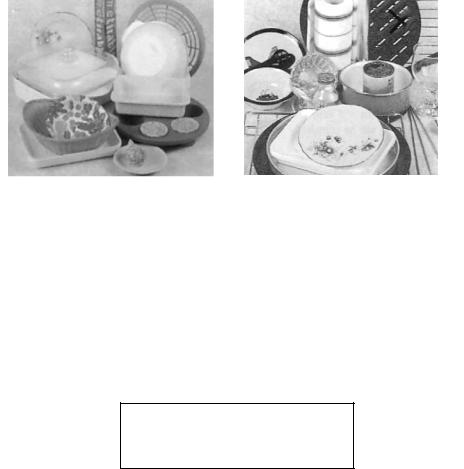
Quick Check Cookware Guide
Microwave
Cooking Containers
●Use plain white kitchen towel for short cooking times only.
DO NOT use patterned kitchen towel.
●DO NOT use melamine dishes.
Use plastic dishes only if designed for microwave use.
●DO NOT cook foods high in fat or sugar, or foods that require a long cooking time (e.g. brown rice, Christmas Puddings) in plastic containers.
●Wicker baskets can be used for very short reheating times only - check these items do not have metal staples.
●Take care with pottery items -
DO NOT use unless completely glazed.
●DO NOT use wooden items for cooking - these will dry out and burn.
Oven Accessories
En-4
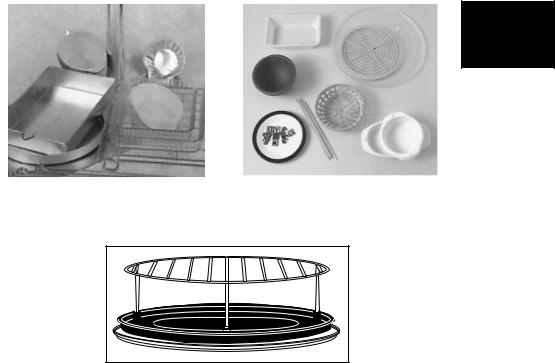
Grill
Cooking Containers
Oven Accessories
English
En-5
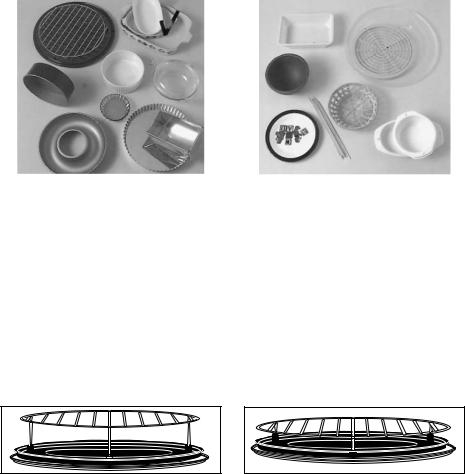
Combination
Cooking Containers
●DO NOT place metal containers directly onto wire rack - place onto metal tray.
●DO NOT use spring form tins for cakes.
●DO NOT use enamelled pie plates for cooking pastry items.
●Should arcing occur when cooking by Combination, press the Stop pad twice to cancel the program, then continue cooking on CONVECTION only.
●DO NOT use dishes with a gold/silver decoration, as these will arc and the pattern will lift off the dish.
Oven Accessories
For more information about combination modes, refer to operating instructions.
En-6
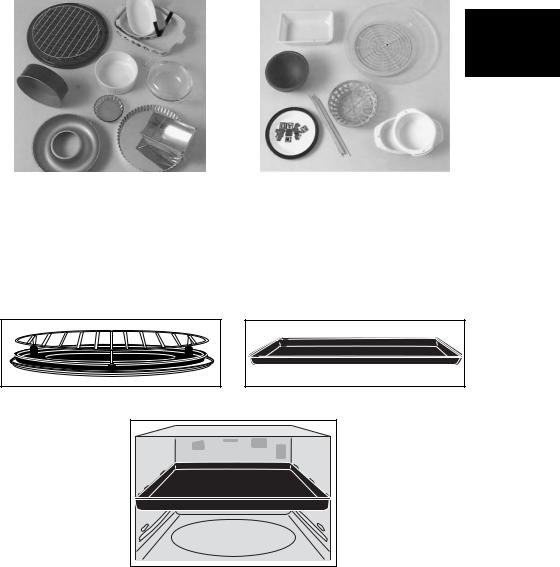
Convection
Cooking Containers
English
●DO NOT use plastic microwave containers unless especially designed to take temperatures of 250°C.
Oven Accessories
En-7
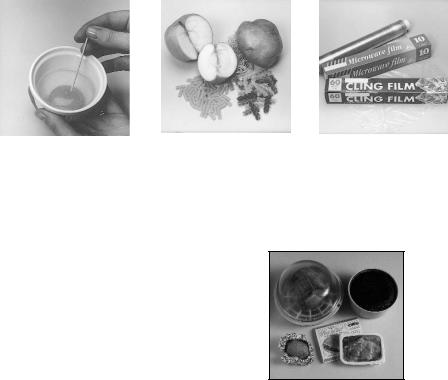
General Guidelines
PIERCING
The skin or membrane on some foods will cause steam to build up during cooking.
These foods must be pierced or a strip of skin should be peeled off before cooking to allow the steam to escape.
Eggs, potatoes, apples, sausages etc, will all need to be pierced before cooking. DO NOT ATTEMPT TO BOIL EGGS IN THEIR SHELLS.
MOISTURE CONTENT
Many fresh foods e.g. vegetables and fruit, vary in moisture content throughout the season. Jacket potatoes are a particular example of this. For this reason cooking times may have to be adjusted throughout the year.
Dry ingredients e.g. rice, pasta, can dry out further during storage and cooking times may differ from ingredients freshly purchased.
CLING FILM
Cling film helps keep the food moist and the trapped steam assists in speeding up cooking times. However it should be pierced before cooking, to allow excess steam to escape. Always take care when removing cling film from a dish as the build-up of steam will be very hot. Always purchase cling film that states on the packet “suitable for microwave cooking” and use as a covering only. Do not line dishes with cling film.
Dense foods e.g. meat, jacket potatoes and cakes, require a STANDING TIME (inside or outside of the oven) after cooking, to allow heat to finish conducting to cook the centre completely.
STANDING TIME
MEAT JOINTS - Stand 8-10 mins. wrapped in tin foil.
JACKET POTATOES - Stand 5 mins. wrapped in tin foil.
LIGHT CAKES - Stand 5 mins. before removing from dish.
RICH DENSE CAKES - Stand 15-20 mins.
FISH - Stand 2-5 mins.
EGG DISHES - Stand 2-3 mins.
PRECOOKED CONVENIENCE FOODS - Stand for 5 mins.
PLATE MEALS - Stand for 2-5 mins.
VEGETABLES - Boiled potatoes benefit from standing for 1-2 mins., however most other types of vegetables can be served immediately.
DEFROSTING - It is essential to allow standing time to complete the process. This can vary from 5 mins. e.g. raspberries, to up to 1 hour for a joint of meat.
If food is not cooked after STANDING TIME, return to oven and cook for additional time.
En-8

|
|
|
General Guidelines |
||||
|
|
|
|
|
|
|
|
Micro Power |
|
|
|
|
Use |
||
|
|
|
|
|
|
|
|
High |
1000 |
W |
|
Reheating meals and sauces, cooking fish, vegetables, |
|||
|
|
|
|
sauces, preserves |
|||
Defrost |
270 |
W |
|
Defrosting frozen foods |
|||
Medium |
600 |
W |
|
Roasting, egg sauces, heating milk, cooking sponge cakes |
|||
Low |
440 |
W |
|
Chicken casseroles, quiches |
|||
Simmer |
250 |
W |
|
Cooking stews and casseroles, rice puddings, rich fruit |
|||
|
|
|
|
cakes, egg custards |
|||
Warm |
100 |
W |
|
Softening ice-cream, butter, cream cheese |
|||
|
|
|
|
|
|
|
|
|
|
|
|
|
|
|
|
English
DISH SIZE
Follow the dish sizes given in the recipes, as these affect the cooking and reheating times. A quantity of food spread in a bigger dish cooks and reheats more quickly.
DENSITY
Porous airy foods heat more quickly than dense heavy foods.
ARRANGING
Individual foods e.g. chicken portions or chops, should be placed on a dish so that the thicker parts are to the outside.
QUANTITY
Small quantities cook faster than large quantities, also small meals will reheat more quickly than large portions.
SHAPE
Even shapes cook evenly. Food cooks better by microwave when in a round container rather than square.
SPACING
Foods cook more quickly and evenly if spaced apart. NEVER pile foods on top of each other.
En-9
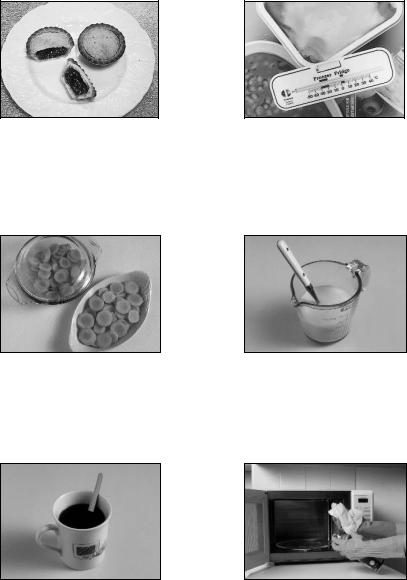
General Guidelines
INGREDIENTS
Foods containing fat, sugar or salt heat up very quickly. The filling may be much hotter than the pastry. Take care when eating. Do not overheat even if the pastry does not appear to be very hot.
STARTING TEMPERATURE
The colder the food, the longer it takes to heat up. Food from a fridge takes longer to reheat than food at room temperature.
COVERING
Cover foods with microwave cling film or a self-fitting lid. Cover fish, vegetables, casseroles, soups. Do not cover cakes, sauces, jacket potatoes, pastry items.
TURNING AND STIRRING
Some foods require stirring during cooking. Meat and poultry should be turned after half the cooking time.
LIQUIDS
All liquids must be stirred before and during heating. Water especially must be stirred before and during heating, to avoid eruption. Do not heat liquids that have previously been boiled. DO NOT OVERHEAT.
CLEANING
As microwaves work on food particles, keep your oven clean at all times. Stubborn spots of food can be removed by using a branded oven cleaner, sprayed onto a soft cloth. Always wipe the oven dry after cleaning. Avoid any plastic parts and door area.
En-10
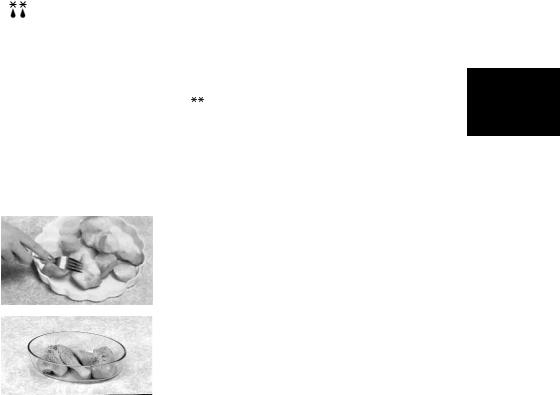
Defrosting Guidelines
The biggest problem when defrosting food in a microwave is to get the inside defrosted before the outside starts to cook.
For this reason Panasonic have made the defrosting on your oven CYCLIC DEFROST, just select the 270 watts DEFROST Min 
 pad and set the required time. The oven then divides this time into 8 stages. These stages alternate between defrosting (total of 4) and standing (total of 4).
pad and set the required time. The oven then divides this time into 8 stages. These stages alternate between defrosting (total of 4) and standing (total of 4).
During the standing stages there is no microwave power in the oven, although the light will remain on and the turnatable will turn. The automatic stand times ensure a more even defrost and for small items the usual stand time can be eliminated.
English
Tips for Defrosting
MINCED MEAT OR CUBES OF MEAT AND SEAFOOD
Since the outside of these foods quickly defrosts, it is necessary to separate them, break the blocks into pieces frequently while defrosting and remove them when they have defrosted.
SMALL PORTIONS OF FOOD
Chops and chicken pieces must be separated as soon as possible so that they defrost evenly throughout. Fatty parts and the ends defrost more quickly. Place them near the centre of the turntable or protect them.
En-11
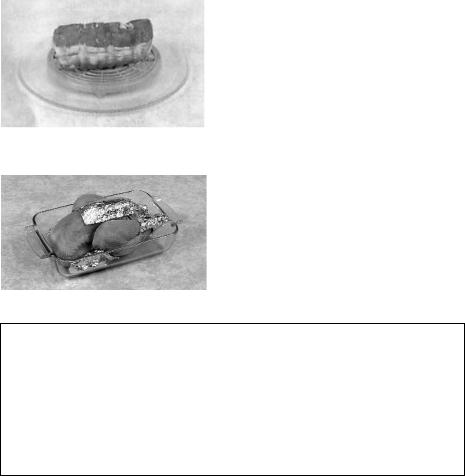
Tips for Defrosting
Check the defrosting several times, even if you use the automatic buttons. Observe the standing times.
STANDING TIMES
Individual portions of food may be cooked almost immediately after defrosting (5 minutes standing time for steaks, 15 minutes for fruit and pastry). It is normal for large portions of food to be frozen in the centre. Before cooking, allow to stand for a minimum of one hour. During this standing time, the temperature becomes evenly distributed and the food is defrosted by conduction. NB If the food is not going to be cooked immediately, store it in the refrigerator. Never refreeze defrosted food without first cooking it.
JOINTS AND POULTRY
It is preferable to place the joints on an upturned plate or plastic rack so that they are not resting in the juices. It is essential to protect delicate or projecting parts of this food with small pieces of foil to prevent these parts from cooking. It is not dangerous to use small pieces of foil in your oven, provided they do not come into contact with the oven walls.
Auto Weight Defrost
This feature allows you to enter the weight |
speeds up the defrosting process, giving a |
|
in grams and the oven will select the correct |
quick and more even defrost. |
|
defrosting time. Do not use for porous foods |
See Operating Instructions for selection of |
|
e.g. bread, cakes and convenience foods |
||
the grams. During the defrosting process, |
||
etc. |
||
the oven will beep to remind you to check |
||
|
||
The Inverter defrost system used in Auto |
the food i.e. turn, shield or break the food |
|
Weight Defrost programs uses a random |
apart, as shown above. |
|
sequence of pulsing microwave energy. This |
|
|
|
|
En-12

13-En
Defrosting Common Foods
Select Defrost PowerMin  270 W then the approximate time given below.
270 W then the approximate time given below.
The times given below are guidelines only. Always check the progress of the food by opening the oven door and then re-starting. For larger quantities adjust times accordingly. It is not essential to cover food during defrosting.
Food |
Weight/quantity |
Time in minutes |
Standing times (minimum) in minutes |
|
MEAT |
|
|
|
|
- joints with bone# |
500 g |
18 |
- 20 |
60 |
- roast filleted# |
500 g |
20 |
- 22 |
70 |
- chops# |
500 g |
8 - 12 |
15 |
|
- cutlets# |
250 g |
6 |
- 7 |
10 |
- kidneys* |
250 g |
7 |
- 8 |
10 |
- lean beef* |
430 g (2) |
11 - 12 |
10 |
|
- entrecôte* |
150 g |
4 |
- 6 |
10 |
- minced beef, sausage meat, pork mince* |
500 g |
10 |
- 12 |
10 |
- hamburger* |
200 g (2) |
6 |
- 7 |
10 |
|
400 g (4) |
10 |
- 12 |
10 |
- meat for stewing/braising* |
500 g |
12 |
- 14 |
15 |
- whole poultry# |
500 g |
12 |
- 13 |
60 |
- poultry pieces# |
1 kg (4) |
22 |
- 24 |
30 |
- poussin# |
400 g |
15 |
30 |
|
- rabbit# |
500 g |
14 |
- 15 |
30 |
- pork sausages* |
300 g (2) |
10 - 11 |
15 |
|
BUTTER |
250 g |
|
2 |
10 |
FRUIT COULIS* |
200 g |
3 |
- 4 |
10 |
CHEESE* |
450 g |
|
3 |
10 |
RED FRUIT* |
250 g |
5 |
- 6 |
10 |
|
300 g |
|
9 |
10 |
|
500 g |
12 |
10 |
|
NOTES
# turn this food halfway through defrosting and protect ends and projecting parts with foil.
*stir, turn or separate several times during defrosting.
English

14-En
Defrosting Common Foods
Select Defrost PowerMin 
 270 W then the approximate time given below.
270 W then the approximate time given below.
The times given below are guidelines only. Always check the progress of the food by opening the oven door and then re-starting. For larger quantities adjust times accordingly. It is not essential to cover food during defrosting.
Food |
Weight/quantity |
Time in minutes |
Standing times (minimum) in minutes |
|
CAKES AND PUDDINGS |
|
|
|
|
- Victoria Sandwich Cake |
400 g (1) |
|
7 |
10 |
- Black Forest |
550 g (1) |
4 |
- 5 |
15 |
- Bavarois |
110 g (1 portion) |
8 seconds |
15 |
|
- raspberry tart |
470 g (1) |
10 |
15 |
|
CONCENTRATED FRUIT JUICE |
200 ml |
|
4 |
4 |
PASTRY |
|
|
|
|
- sweet flan or shortcrust* |
370 g (block) |
4 |
- 5 |
5 |
- puff* |
300 g (block) |
3 |
- 4 |
5 |
FISH |
|
|
|
|
- whole# |
400 g (2) |
10 |
- 12 |
15 |
- fillets# |
500 g (4) |
13 |
- 14 |
15 |
- fish steak with bone* |
380 g (2) |
10 |
15 |
|
- thick steaks without bone* |
200 g (2) |
|
9 |
15 |
- shrimps/prawns* |
200 g |
|
7 |
10 |
NOTES
# turn this food halfway through defrosting and protect ends and projecting parts with foil.
*stir, turn or separate several times during defrosting.

Reheating
Many convenience foods are readily available in supermarkets. You may also wish to reheat homecooked food or leftovers. This can all be done safely in your oven, however you must check the food carefully to see if it is piping hot before serving, just as you would in a conventional oven.
Chilled foods to be reheated must also be stored correctly.
How do I choose which method to reheat by?
The heat method i.e. Microwave only or Combination, depends on the type of food to be reheated. For foods that do not require browning, reheat by microwave only. For foods that do require browning, reheat by
Combination.
How long do I reheat foods for?
There are reheating charts for Microwave and Combination: these charts give timings that are a guideline ONLY, as the exact time will depend on the weight of the food, size of the dish used and start temperature.
What should I do if the food I am reheating does not appear in the charts?
It is not possible to test every food available for the following charts, however we have selected a great variety of foods, and suggest that by following the guidelines given, you can reheat safely and successfully.
Stirring and Turning
Whenever possible, foods should be stirred or turned over during reheating. This helps ensure that the food reheats evenly on the outside and in the centre.
Standing Time
Many foods require a STANDING TIME after reheating. Standing time is a rest time which allows the heat in the food to continue to transfer to the centre, thus eliminating cold spots. If the food has been covered during the reheating time, then leave the covering on during the standing time. Stand time is particularly important for dense foods e.g. Lasagnes, Gratins, etc and those foods that cannot be stirred during reheating.
When is food reheated?
Reheated food should be served “piping hot” i.e. steam should be visibly emitted from all parts. As long as good hygiene practices have been followed during the preparation and storage of the food, then reheating by microwave or Combination present no added safety risks.
Foods that cannot be stirred should be cut with a knife to test that they are well heated through.
Even if manufacturer’s instructions or the times in the reheating charts have been followed, it is still important to check that the food is piping hot. If in doubt, always return the food to your oven for further reheating.
English
En-15

Microwave Cooking Tips
To soften butter for easy spreading on removal from the fridge
Soften for 35-40 seconds on 270 W 
 (for 150g). Remove any foil beforehand.
(for 150g). Remove any foil beforehand.
Swelling dried fruit
Add 4 tablespoons of water to 200 g of raisins or prunes, (they can be swollen with rum for cakes). Stir and heat on 1000 W for 2 to 3 minutes. Allow to stand for 10 minutes.
Restoring cheese to room temperature
Cheese removed from the refrigerator must be placed in the oven and "warmed" for 30 seconds-1 minute (depending on the size of the cheese) at 250 W.
Blanching almonds or hazelnuts
Cover with hot water and cook for 3-6 minutes on 1000 W (return to boil). Cool, drain and the skin is then easy to remove.
Drying herbs
Place absorbent paper on the turntable. Carefully spread out the finely chopped, fresh herbs on the paper. Repeat several times if necessary. Heat on 1000 W for a few minutes, checking them every 30 seconds until the herbs begin to dry. Extreme care must be taken to ensure that the herbs do not remain in the oven too long; otherwise, they will disintegrate, and possibly catch fire. Leave the herbs on the absorbent paper for a further 2 hours at room temperature, then store in airtight containers.
Making caramel
Cook 100 g of sugar with 2 tablespoons of water in a bowl for 2-3 minutes on 1000 W, checking halfway-through cooking time.
Remove caramel before it becomes darkened since it will continue to cook outside. You can stop the cooking with 2 tablespoons of very hot water (beware of sharp edges).
Liquifying hardened honey
Remove the lid to the pot, place in oven and heat on 250 W for 30-50 seconds, depending on the quantity. Stir and repeat if necessary.
Croutons in minutes
Cut two slices of white bread into small cubes. Spread out these cubes on a plate. Heat on
1000 W for 2 minutes then allow to stand for 5 minutes. You can rub a clove of garlic on the slices of bread before cutting them or drizzle with a few drops of olive oil.
How to obtain more juice from an orange or a lemon
Before squeezing, place orange or lemon in microwave for 30-40 seconds on 1000 W, then squeeze immediately; this will produce more juice.
Melting butter
100g of butter in a ramekin dish covered with a saucer will melt in around 1 minute at
600 W.
Melting chocolate
Break 100 g chocolate into little pieces into a bowl and heat at 600 W for 2-21/2 minutes (the time may vary depending on the cocoa and sugar content). Stir at least once during cooking.
Leaving dough to prove
Place the covered dough in the oven and heat for around 5 minutes on 270 W  (for 500 g of dough). Leave the dough in the oven (away from air currents) until it has doubled in volume.
(for 500 g of dough). Leave the dough in the oven (away from air currents) until it has doubled in volume.
Making mulled wine
In an ovenproof glass (or mug), mix together 20 CL of red wine, the zest of a lemon, a pinch of cinnamon, one clove and 2-4 teaspoons of sugar according to taste. Heat on 1000 W for 1-11/2 minutes.
"Deodorise" your oven
To rid your oven of that "fishy" smell, place a bowl of white wine vinegar or water with the juice of a lemon inside the oven. Heat on 1000 W for 5 minutes. Wipe off the steam that collects on the oven walls.
Preparing a hot compress
Heat a clean, damp, folded cloth on a plate for
1-2 minutes on
1000 W. Check temperature before applying the cloth.
En-16
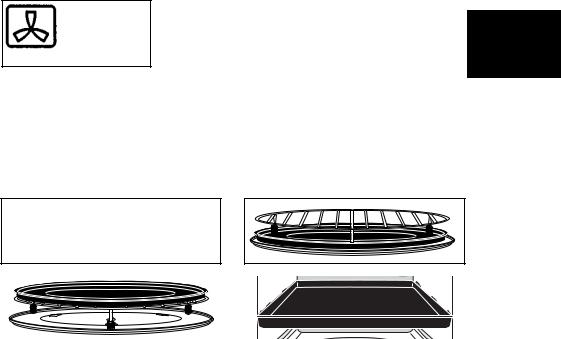
Convection/Bake Cooking
Your oven can be used as a conventional
oven using the CONVECTION/BAKE mode, which incorporates rear heating element with a fan to circulate the air on the CONVECTION/BAKE mode.
Fan assisted ovens are very efficient therefore foods can be cooked quickly at a lower temperature, saving time and energy when the CONVECTION/BAKE
mode is used.
When using the oven on CONVECTION/BAKE there is NO microwave power, i.e. the oven is operating as a conventional oven and you can use all your standard metal baking tins and ovenware.
REMEMBER: If the CONVECTION mode is used, in most instances it will be necessary to reduce the temperature by 20°C when using cooking temperatures stated in other cookbooks.
English
|
|
|
|
|
|
|
|
|
|
|
|
|
|
|
|
|
|
|
|
|
|
|
|
|
|
|
|
|
|
|
|
|
|
|
|
|
|
|
|
|
|
|
|
TEMPERATURE |
|
|
|
USE |
||||||
|
(PREHEAT OVEN) |
|||||||||
|
|
|
|
|
|
|
||||
|
|
|
|
|
|
|
|
|
|
|
100-110°C |
Meringues |
|||||||||
|
|
|
|
|
|
|
|
|
|
|
120-140°C |
Meat and Fish Terrines, Potted Meats, Drying Herbs |
|||||||||
|
|
|
|
|
|
|
|
|
|
|
150-170°C |
Poached Eggs, Fruit Cakes |
|||||||||
|
|
|
|
|
|
|
|
|
|
|
180-190°C |
Quiches, Flans, Crème Caramels, Macaroons, White Meat, |
|||||||||
|
|
|
|
|
|
Braised and Stewed Meat |
||||
|
|
|
|
|
|
|
|
|
|
|
200-220°C |
Genoise, Soufflés, Whole Fish, Savarins |
|||||||||
|
|
|
|
|
|
|
|
|
|
|
|
|
|
|
230°C |
Poultry, Choux Pastry |
|||||
|
|
|
|
|
|
|
|
|
|
|
240-250°C |
Pizzas, Tarts, Biscuits, Small Puffed Pastries, Fruit Tarts, |
|||||||||
|
|
|
|
|
|
Small Brioches, Rolled Biscuits, Red Meats |
||||
|
|
|
|
|
|
|
|
|
|
|
En-17

Grilling/Grill-Convection Cooking
Grill:
There are 3 GRILL settings: 1, 2 and 3. Most meat foods can be cooked on the hottest GRILL 1 setting. GRILL 2 and 3 settings are used for more delicate foods, or those that require a longer grilling time e.g. chicken portions. Unless otherwise stated in a chart or recipe, always use GRILL 1 setting.
Grill-Convection
The GRILL with fan-forced-air allows large pieces of meat to be properly cooked and roasted e.g. white meat, large pieces of poultry, finishing for gratin.
There is NO MICROWAVE POWER ON THE GRILL/CONVECTION-GRILL PROGRAM.
Approximate Times for Grilling (GRILL 1)
|
First side |
Second side |
Steak (4 pieces, well done) |
10-12 mins. |
10-12 mins. |
Loin of pork (slices) |
12-14 mins. |
10-12 mins. |
Porkchops |
12-14 mins. |
12-14 mins. |
Kebabs |
12-14 mins. |
approx. 12 mins. |
Sausages |
7-8 mins. |
6-8 mins. |
Chicken legs |
15-20 mins. |
15-20 mins. |
Toast |
4-5 mins. |
3-4 mins. |
Grill-Convection Guide
Grill |
|
Oven |
Food |
Setting |
|
Temperature (°C) |
|
|
|
||
|
|
|
|
|
|
100°C ● 110°C |
Meringues |
3 (Low) |
|
120°C |
Meat and fish pâtés, Herb drying |
|
|
150°C |
Sponge cakes |
|
|
170°C |
Quiches, baked custard |
2 (Medium) |
|
180°C |
Soufflés, caramel custard, macaroons |
|
|
190°C |
Fish, large pieces of pastry, braised meat, |
|
|
|
stewed meat |
|
|
200°C ● 210°C ● 220°C |
White meat, choux, duck, open tarts |
1 (High) |
|
230°C |
Roasted red meat, poultry, big brioches, |
|
|
|
large puffed pastry |
|
|
240°C ● 250°C |
Small puffed pastry, small brioches |
En-18
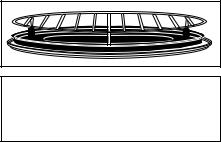
Combination Cooking -
Convection + Micro Power
|
|
English |
quickly, whilst the oven gives the |
which cook quickly by CONVECTION will |
|
Combination cooking is ideal for many |
Not all foods are suited to cooking by this |
|
foods. The microwave power cooks them |
method and in many cases small items |
|
traditional browning and crispness. All this |
not gain anything by being cooked by |
|
happens simultaneously, resulting in most |
Combination. |
|
foods being cooked in 1/2-1/3 of the |
|
|
conventional cooking time. |
|
|
|
|
|
FOODS NOT SUITABLE FOR
COMBINATION COOKING
Biscuits
Boneless Convenience Joints
Meringues
Rich Fruit Cakes
Souffles
Small pastry items with a very moist filling
Unboiled Gammon
Whisked Sponge Cakes
En-19

Combination Cooking -
Convection + Micro Power
The chart below describes the oven temperature and microwave power which will enable you to adapt your favourite recipes to Combination cooking and also when using the many Combination cookery books available.
Oven Temperature |
Microwave Power |
|
Use |
230°C |
100 W |
Cooking: |
Chicken Portions and |
|
Breasts, Crisp Baked |
||
|
|
|
|
|
|
|
Potatoes, Chops |
|
|
Reheating: |
Pizza, Garlic Bread, |
|
|
|
Savouries |
|
|
Cooking: |
Pastry Pies, Pizza, |
220°C |
250 W |
|
Bread, Chicken |
|
|
|
Portions in |
|
|
|
Breadcrumbs |
|
|
Reheating: |
Lasagnes, |
|
|
|
Cannelloni, |
|
|
|
Cauliflower Cheese |
190°C |
100 W |
Cooking: |
Quiche, Custard |
|
|
|
Tarts, Sponge-based |
|
|
|
Puddings |
|
|
|
|
190°C |
250 W |
Roasting: |
Chicken, Duck, |
|
|
|
Turkey |
|
|
Cooking: |
Lasagnes, Gratins |
170°C |
440 W |
Roasting: |
Joints of Lamb, Beef, |
|
|
|
Pork |
160°C |
100 W |
Cooking: |
Cakes (eg Madeira, |
|
|
|
Light Fruit etc.) |
|
|
|
Casseroles, Rice |
|
|
|
Puddings, Meat |
|
|
|
Terrines |
|
|
|
|
Foods that should be cooked on Combination + Microwave power, are meat recipes and egg dishes, as this reduces shrinkage.
En-20

Combination Cooking
21-En
Table for reheating everyday or frozen foods in microwaves or combination ovens.
Directions for use : the indication "+" signifies combined cooking , FA refers to Fan-Assisted [cooking], and TB to Turbogrill. In all Combination cooking, the oven must be preheated at the temperature indicated with the metal tray placed on the turntable.
Food |
Weight or Quantity |
Fresh |
Frozen |
|
||
|
|
|
|
|
||
CATERING STARTERS |
|
|
|
|
||
|
|
|
|
|||
- croque-monsieur (2 & 4) |
1 pce (140 g) |
TB 230° + 250W 4 to 5 min |
Grill + 600W 4 to 5 min |
|||
|
[ham & cheese toastie] |
2 x 140 g |
FA 210° + 250W 7 min then 1 min TB 230° |
Grill 2 + 440W 7 min |
||
|
|
|
|
|
||
- scallop of fish (1) |
1 x 150 g |
Grill + 600W 2 min 30 then 1 min Grill |
Grill + 600W 5 to 7 min |
|||
1 x 100 g |
- |
TB 180° + 440W 6 min |
||||
|
|
|||||
|
|
|
|
|
||
- |
cheese croissant (2) |
1 x 170 g |
FA 210° + 250W 3 to 4 min |
FA 210° + 440W 4 min |
||
- puff pastry roll with cheese filling (6) |
1 x 130 g |
FA 200° + 250W 3 to 4 min |
FA 210° + 440W 4 to 5 min |
|||
|
|
|
|
|||
- ham-cheese baskets (to be cooked) |
2 x 120 g |
- |
FA 240° + 250W 9 min |
|||
|
(6) |
|
|
|
|
|
- ham-cheese or goat's cheese-spinach |
2 x 110 g |
FA 230° + 250W 3 min |
- |
|
||
|
baskets (cooked) (2) |
|
|
|
|
|
- |
meat pie (2) |
2 x 170 g |
FA 200° + 100W 5 min |
- |
|
|
|
|
1 x 125 g |
FA 200° + 100W 3 to 4 min |
TB 200° + 440W 2 min 30 sec |
||
- |
ham-mushroom-cheese pastry |
1 x 120 g |
FA 210° + 250W 3 to 4 min |
FA 200° + 440W 4 to 5 min or Autosetting - |
||
|
(cooked) (2) |
|
|
quiche |
then 5 min FA 210° |
|
|
|
|
|
|||
- Cheese soufflé (to be cooked) (5) |
2 x 120 g |
- |
FA 200° + 250W 15 to 17 min |
|||
|
|
|
|
|
|
|
- |
Pastilla [Moroccan chicken pie] |
2 x 100 g |
- |
FA 250° + 250W 10 to 12 min |
||
|
(to be cooked) (2) |
|||||
|
|
|
|
|
||
|
|
|
|
|
|
|
English
22-En
Combination Cooking
Table for reheating everyday or frozen foods in microwaves or combination ovens.
Directions for use : the indication "+" signifies combined cooking , FA refers to Fan-Assisted [cooking], and TB to Turbogrill. In all Combination cooking, the oven must be preheated at the temperature indicated with the metal tray placed on the turntable.
Food |
Weight or Quantity |
Fresh |
Frozen |
|
|
|
|
|
|
- |
Panini (2) |
1 x 140 g |
FA 230° + 250W 2 min |
- |
|
|
|
|
|
- |
Cheese pastry (7) |
20 pces –150 g |
- |
FA 200° + 250W 5 to 6 min |
|
|
|
|
|
- Chips in bread roll (2) |
1 x 110 g |
TB 200° + 250W 3 to 4 min |
Grill 1 + 440W 4 to 5 min |
|
|
|
|
|
|
- |
Sweetbread vol-au-vent (2) |
4 x 140 g |
FA 230° + 250W 7 min 30 sec |
- |
|
|
|
|
|
- aperitif pastries (to be cooked) (6) |
16 pces (210 g) |
FA 210° + 100W 5 min |
FA 240° + 100W 12 to 13 min |
|
- aperitif tartlets (already cooked) (2) |
12 pces (160 g) |
FA 210° 5 min |
FA 230° + 100W 5 to 6 min |
|
- Mini St jacques scallops (1) |
12 pces (220 g) |
- |
Grill 1 + 250W 6 min |
|
|
|
|
|
|
- large crayfish pastries, tourte |
1 x 450 g |
FA 230° + 250W 8 to 9 min (2) |
Preheat in FA 250° and cook FA 230° + 250W 18 to |
|
|
bourguignonne ou bretonne |
1 x 500 g |
- |
20 min then 3 min in FA 230° (6 for the puff pastry) |
|
(to be cooked) |
|
|
(5 in its tin for the shortcrust pastry pie) |
|
|
|
|
|
- Spring rolls, samosas (2 & 4) |
8 pcs (660 g) |
TB 230° + 100W 8 min |
- |
|
|
|
|
|
|
- Stuffed [baked] potatoes (2) |
2 x 200 g |
Grill 1 + 600W 4 min 30 sec |
- |
|
|
|
|
|
|
- |
Tielle sétoise (7) |
1 x 350 g |
FA 240° + 250W 3 min |
- |
|
|
|
|
|
- |
Filled pancake (3) |
1 x 150 g |
Max 2 min |
Max 3 to 4 min |
- |
Unfilled pancake (3) |
1 pce |
Max 20 to 30 sec |
- |
|
|
|
|
|
- |
Snails (3) |
12 pcs 120 g |
250W 3 to 4 min |
440W 3 to 4 min in their container |
|
|
|
|
|
- |
Stuffed tomato (3) |
1 pce 170 g |
Max 2 min |
Max 4 to 6 min |
|
|
|
|
|
- Plain or onion tortilla |
1 x 500 g |
Max 3 to 4 min. |
- |
|
|
|
|
|
|
- |
Lyon saveloy in brioche (7) |
1 x 400 g |
FA 200° + 440W 8 min then stand 5 min |
- |
|
|
|
|
|

Combination Cooking
Table for reheating everyday or frozen foods in microwaves or combination ovens.
Directions for use : the indication "+" signifies combined cooking , FA refers to Fan-Assisted [cooking], and TB to Turbogrill. In all Combination cooking, the oven must be preheated at the temperature indicated with the metal tray placed on the turntable.
Food |
Weight or Quantity |
Fresh |
Frozen |
|
|
||
|
|
|
|
|
|||
- |
calzone pizza (2) |
1 x 380 g |
FA 200° + 250W 6 min |
FA 210° + 440W 9 to 11 min |
|||
- |
pizza (2) |
1 x 120 g |
Autosetting - pizza |
Autosetting - pizza |
|||
|
|
1 x 500 g |
Autosetting - pizza |
Autosetting - pizza |
|||
- |
American pizza (2) |
1 x 500 g |
- |
FA 230° + 600W 7 min then grill 2 to 3 min |
|||
|
|
1 x 750 g |
|
Or Pizza |
+ 4 min FA 220° |
||
|
|
- |
FA 230° + 600W |
9 min then Grill 2 to 3 min |
|||
|
|
|
|
|
|
||
- |
Quiche lorraineOnion & bacon tart (2) |
1 x 100-130 g |
FA 200° + 100W 3 min |
FA 200° + 440W |
4 to 5 min |
||
1 x 400 g |
FA 200° + 100W 4 min 30 sec |
Autosetting - quiche |
|||||
|
|
||||||
- |
Family-size leek quiche (2) |
1 x 1000 g |
FA 180° + 100W 7 to 8 min then stand |
FA 180° + 440W |
15 min then 8 min standing time |
||
|
|
||||||
|
|
|
|
|
|||
- |
Alsace tart/flan (2) |
1 x 130 g |
Autosetting - pizza fresh |
Autosetting - pizza |
|||
|
|
|
|
|
|
|
|
(1) place in a heat-resistant, microwaveable dish on the high wire rack. (2) remove all packaging and place directly on high wire rack. (3) cover. (4) turn over or stir halfway through cooking. (5) place on metal tray. (6) place on a sheet of greaseproof paper on the high wire rack. (7) place on a sheet of greaseproof paper on the low wire rack. STANDING TIME : it is essential to let the food stand after reheating : 3 to 6 min for the starters, bread, Viennese pastries, liquids, ready meals and 10 min for the gratins and pies.
23-En
English

24-En
Combination Cooking
Table for reheating everyday or frozen foods in microwaves or combination ovens.
Directions for use : the indication "+" signifies combined cooking , FA refers to Fan-Assisted [cooking], and TB to Turbogrill. In all Combination cooking, the oven must be preheated at the temperature indicated with the metal tray placed on the turntable.
Food |
Weight or Quantity |
Fresh |
Frozen |
|
||
|
|
|
|
|
||
READY MEALS |
|
|
|
|
||
|
|
|
|
|
|
|
- |
Gratins (dauphinois, moussaka, |
300-400 g (1) |
TB 200° + 600W 5 min |
Autogratin |
|
|
800 g (1) |
TB 230° + 600W 7 to 9 min |
Autogratin |
|
|||
|
lasagna, tartiflette, Shepherd's pie) |
|
||||
|
1 kg (7) |
FA 250° + 600W 11 to 12 min |
Autogratin |
or TB2 230° + 600W 22 min |
||
|
|
|||||
|
|
|
|
|
||
- Vegetable gratin (with or without |
300 g |
Grill 1 + 440W 6 to 7 min (1) |
Autogratin |
|
||
|
meat) |
320-400 g |
TB 200° + 600W 7 min (1) |
Autogratin |
|
|
|
|
800 g |
TB 230° + 600W 10 min (1) |
Autogratin |
|
|
|
|
|
|
|
||
- Dumplings (3 & 4) |
4 pcs 320 g |
440W 4 min |
- |
|
||
|
|
|
|
|
|
|
- |
Fish à la bordelaise [with white wine & |
450 g |
- |
TB 230° + 600W 11 to 12 min (7) |
||
|
shallots] |
|||||
|
|
|
|
|
||
|
|
|
|
|
||
SIDE DISHES |
|
|
|
|
||
|
|
|
|
|
||
- Starchy foods (3 & 4) |
300 |
Max 2 to 3 min |
Max 4 to 5 min |
|
||
|
|
|
|
|||
- Oven chips & potato products |
300 to 500 g |
- |
Grill 1 + 600W 7 to 10 min according to brand and |
|||
|
(1 & 4) |
|
|
thickness of product |
||
|
|
|
|
|
|
|
- |
Vegetables (3 & 4) |
100 g |
Max 1 min to 1 min 30 sec |
- |
|
|
|
|
200 g |
Max 1 min 30 to 2 min |
- |
|
|
|
|
|
|
|
||
- Mashed (3 & 4) |
|
|
|
|
||
|
potato |
200 g |
Max 1 min 30 sec |
Max 3 min |
|
|
|
vegetables |
200 g |
Max 1 to 2 min |
Max 3 min 30 sec |
||
|
|
400 g |
Max 3 min 30 sec |
Max 8 min |
|
|
|
|
1000 g |
- |
Max 12 to 13 min |
||
|
|
|
|
|
|
|
|
|
200 g |
Max 2 min |
- |
|
|
- |
Spaghetti in sauce (3) |
500 g |
Max 4 min |
- |
|
|
|
|
1000 g |
Max 7 to 8 min |
Max 13 to 14 min (4) |
||
- |
Rice (3) |
150 g |
Max 1 min |
Max 2 min 30 sec |
||
300 g |
Max 2 min 30 sec |
Max 4 min 30 sec |
||||
|
|
|||||
|
|
|
|
|
|
|
